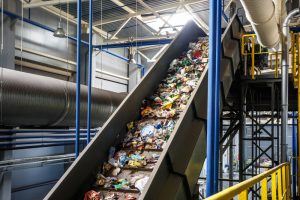The EPA on November 15 announced the release of the 2021 National Recycling Strategy “to tackle major recycling challenges facing the nation and to create a stronger, more resilient, and cost-effective municipal solid waste recycling system.” For the first time, the plan includes measures to address the climate impacts of producing, using, and disposing of materials along with the impacts of waste and waste-related facilities located in environmental justice (EJ) communities.
Challenges for recycling in the United States include reduced markets for recycled materials, recycling infrastructure that has not kept pace with today’s diverse and changing wastestream, confusion about what materials can be recycled, and varying methodologies to measure recycling system performance.
The 2021 National Recycling Strategy includes five objectives to strengthen the U.S. recycling industry:
- “Improve markets for recycled commodities through market development, analysis, manufacturing, and research.
- Increase collection of recyclable materials and improve recycling infrastructure through analysis, funding, product design, and processing efficiencies.
- Reduce contamination in the recycled materials stream through outreach and education to the public on the value of proper recycling.
- Enhance policies and programs to support recyclability and recycling through strengthened federal and international coordination, analysis, research on product pricing, and sharing of best practices.
- Standardize measurement and increase data collection through coordinated recycling definitions, measures, targets, and performance indicators.”
It also provides focused activities to move the Agency forward in targeted areas:
- “Increasing Equitable Access for Overburdened Communities: EPA recognizes the burden that living near waste and waste-related facilities has on communities when waste is not properly managed, which can lead to higher levels of chronic health issues. The 2021 Strategy will increase equitable access to recycling services, reduce environmental impacts in communities, stimulate economic development, and ensure overburdened communities meaningfully participate during the strategy’s implementation.
- “Reducing Climate Impacts of Materials Management: The 2021 Strategy includes a commitment by EPA to create a new national goal to reduce the climate impacts from the production, consumption, use, and disposal of materials, which make up approximately 50 percent of global greenhouse gas emissions, according to the United Nations Environment Programme’s International Resource Panel. This new climate goal will help achieve President Biden’s commitment to achieve a 50-52-percent reduction from 2005 levels in economy-wide net greenhouse gas emissions by 2030.
- “Managing Materials for a Circular Economy: While this initial 2021 Strategy focuses on the recycling of municipal solid waste (MSW), additional work is necessary to create a ‘circular economy’ where materials (e.g., plastics, food waste, electronics, and industrial materials) are sustainably managed throughout their lifecycle. EPA, in coordination with other federal agencies and interested stakeholders, intends to release subsequent strategies that will encompass other activities beyond the recycling of MSW, reflecting the need for sustainable product design, reducing waste generation, and materials reuse activities critical to realizing circularity. Subsequent strategies will address other key materials, such as plastics, food, cement and concrete, as well as electronics.”
In response to the release of the EPA recycling strategy, the American Chemistry Council (ACC) issued a statement welcoming the strategy. “We look forward to working closely with EPA and Congress to accelerate the expansion and modernization of U.S. recycling,” says Joshua Baca, the ACC’s vice president of plastics.
Some critics say the strategy fails to address important issues to increase recycling.
“There needs to be a more robust commitment to waste reduction,” says Judith Enck, a former senior EPA official during the Obama administration who now heads the Beyond Plastics advocacy organization, in The Washington Post. “The problem is that there’s just too much plastic packaging foisted on American consumers.
“Center for International Environmental Law President Carroll Muffett agreed, saying that even if the United States moves toward higher recycling rates, it won’t matter if consumption isn’t curbed.”
“We’re racing a moving target,” he says. “Recycling is not really the solution to the plastics crisis. Until we have national policies that are actually addressing the expansion of single-use disposable plastics that are driving that crisis, I think it’s likely to continue to mask the true source of the problem.”
Other critics say that chemical recycling is not really recycling at all.
“Chemical recycling is being held up by the industry as a cure-all,” says Neil Tangri, science and policy director for the advocacy organization Global Alliance for Incinerator Alternatives, in The Washington Post. But, he adds, the technology often doesn’t work if the recycling stream is dirty. It can be energy-intensive and doesn’t necessarily result in high enough quality plastic resin for repurposing, he notes. “You’re calling it recycling,” says Tangri, “but mostly you’re turning plastic into carbon dioxide and waste.”
Although not all agree that the plan goes far enough, many critics agree the plan is a good initial step in the right direction.

